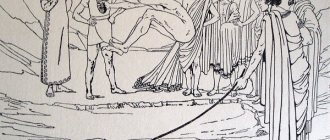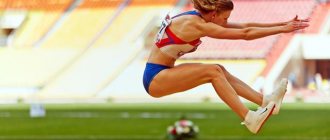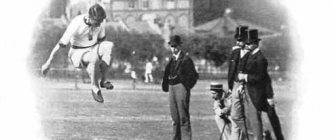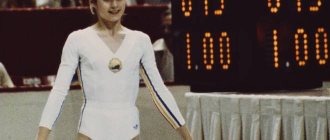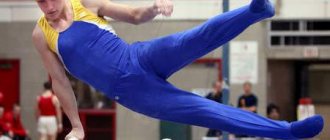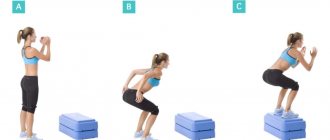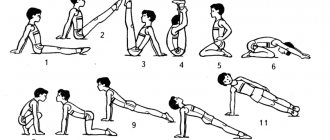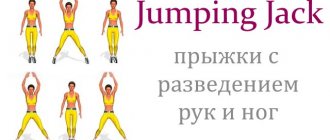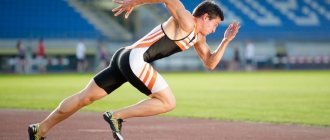Standing and running long jumps require a certain technique of execution, which is best mastered with a coach. When mastering it yourself, you should be careful to avoid injury. Exercises should be performed in a special sector for jumping.
A standing long jump with a push with both legs is provided as an exercise for selecting degrees I-VII of the GTO complex (from 6 to 39 years old). The running long jump is provided as an alternative to the standing jump, but only for age groups from 9 to 24 years. That is, when passing the tests, the participant is required to choose either one or another discipline.
Rules for performing a jump
Long jump can act as one of the all-around elements. In addition, the athlete can perform them separately for his harmonious development. The skills of such jumps are not limited to applied knowledge alone, this exercise is a great way to develop speed and strength.
How are they carried out?
Standing long jumps, the standards of which are passed at school, have a certain technique of execution. Jumps are performed by simultaneously lifting both legs off the floor or ground. The main task of the jumper is to land a long distance from the starting point of the jump, and during landing, perform several correct movements, in particular: the jumper must straighten up.
Afterwards, you can come out of the landing and begin to measure the distance over which the jump was made. For measurements, it is necessary to draw a straight line from the point at which the jump begins to the point at which it ends . It is important to remember that the point of contact is the closest point where any part of the jumper’s body touches the floor or ground.
Initial training
To achieve good results, it is necessary to carry out appropriate preparation and strengthen the muscles of the lower extremities. Before jumping, a comprehensive warm-up must be performed. It will help prevent possible injuries.
Exercises that help you achieve the best results when jumping include:
- jumping out of a squat;
- barbell squats;
- dumbbell calf raises;
- jumping on a horse.
All these movements develop the muscles of the lower extremities, making the push more powerful. To make it easier to group while in the air after the push and before landing, you should perform exercises aimed at strengthening the abdominal and back muscles.
For example:
- pull-ups;
- push ups;
- stand in plank.
Thanks to multi-joint exercises, you can develop coordination. The better it is developed, the easier it will be for the athlete to control his own body in the air. In addition, you will need to perform a set of movements to generally strengthen the muscles of the body.
These include:
- deep squats;
- moving in single file;
- rotation of the feet;
- calf raises.
Each of these exercises is of great importance, because they not only strengthen the muscles, but also prevent possible bruises, injuries and sprains.
Standards for enrollment in athletics groups
Jumping Table 1 Standards for physical fitness for enrollment in educational and training groups (boys)
| No. | Test exercises | Type of jumps | ||
| Height | Length | Pole | ||
| 1. | Result in the main type of jumping, m | 1,25-1,40 | 4,20-4,70 | Not Installed |
| 2. | Result in adjacent jumping event, m | 4,20-4,70 | 1,25-1,40 | 3,90-4,15 |
| 3. | Standing long jump, m | 1,92-2,15 | 1,92-2,15 | 1,90-2,05 |
| 4. | Fivefold (triple) standing jump, m | 5,85-6,45 | 9,82-11,00 | 5,80-6,20 |
| 5. | 30 m running, s | 4,65-4,15 | 4,65-4,15 | 4,80-4,65 |
| 6. | 150 m run by movement, s | 26,8-23,9 | 26,8-23.9 | 27,0-24,8 |
Table 2 Physical fitness standards for enrollment in educational and training groups (girls)
| № p/p | Test exercises | Type of Jumps | |
| Height | Length | ||
| 1. | Result in the main type of jumping, m | 1.16-1,25 | 3,90-4,21 |
| 2. | Result in adjacent jumping event, m | 3,60-3,87 | 1,09-1,18 |
| 3. | Standing long jump, m | 1,72-1,85 | 1,81-1,95 |
| 4. | Fivefold (triple) standing jump, m | 5,01-5,40 | 8,88-9,59 |
| 5. | 30 m running, s | 5,17-4,80 | 4,84-4,48 |
| 6. | 150 m run by movement, s | 28,5-26,4 | 27,6-25,6 |
Note. In the triple jump and pole vault, the formation of groups begins with the UTG of the 3rd year of study. Table 3 Standards for physical training for enrollment in sports improvement groups of the first year of study (boys)
| No. | Test exercises | Types of jumps | |||
| Height | Length | Triple | Pole | ||
| 1. | Result in the main type of jumping, m | 1,91-2,04 | 6,36-6,95 | 13,35-14,34 | 4,20-4,61 |
| 2. | Long jump (triple) from 10-12 b.s. takeoff run, m | 5,86-6,26 | 5,79-6,33 | 12,61-13,55 | 5,80-6,37 |
| 3. | Five-time jump jump on a push leg with 6-8 b.s. takeoff run, m | 18,15-19,38 | 18,32-20,02 | 18,78-20,18 | 17,75-19,15 |
| 4. | Triple, jumping off from a support 90 cm, m | 8,40-8,97 | 8,53-9,32 | 8,78-9,43 | 8,35-8,95 |
| 5. | 40m sprint by movement, s | 5,48-5,13 | 5,19-4,75 | 5,29-4,93 | 5,50-5,25 |
| 6. | 150 m run by movement, s | 19,6-18,4 | 18,4-16,9 | 19,1-17,7 | 20,2-18,4 |
| 7. | Squat with a barbell of maximum weight on the shoulders, kg | 89,9-91,8 | 90,0-98,3 | 94,5-101,5 | 88,7-95,2 |
| 8. | Five quick squat get-ups with 75% body weight, with | 6,98-6,54 | 6,65-6,09 | 6,65-6,30 | 7,05-6,60 |
| 9. | Shot throw (4 kg) from below and forward from i. p. standing facing the throwing sector, m | 14,30-15,27 | 14,35-15,68 | 14,76-15,85 | 14,10-15,05 |
Table 4 Standards for physical training for enrollment in sports improvement groups of the first year of study (girls)
| No. | Test exercises | Type of jumps | ||||
| Height | Length | |||||
| 1. | Result in the main type of jumping, m | 1,67-1,76 | 5,72-6,03 | |||
| 2. | Long jump (triple) from 10-12 b.s. takeoff run, m | 5,12-5,39 | 10,40-10,96 | |||
| 3. | Five-time jump jump on a push leg with 6-8 b.s. takeoff run, m | 15,61-16,45 | 16,18-17,06 | |||
| 4. | Triple, jumping off from a support 45 cm, m | 7,26-7,65 | 7,76-8,18 | |||
| 5. | 40m sprint by movement, s | 5,85-5,55 | 5,58-5,30 | |||
| 6. | 150 m run by movement, s | 20,6-19,6 | 20,3-19,2 | |||
| 7. | Squat with a barbell of maximum weight on the shoulders, kg | 61,6-65,0 | 61,0-64,4 | |||
| 8. | Five quick squat get-ups with 75% body weight, with | 6,98-6,68 | 6,85-6,50 | |||
| 9. | Shot throw (3 kg) from below and forward from i. p. standing facing the throwing sector, m | 12,01-12,66 | 12,57-13,25 | |||
Hurdling Table 1 Standards for enrollment in the first year of study in educational and training groups and groups for improving sports and higher sports skills
| Test exercises | Educational and training groups (from 12 years old) 110 m s/b, 100 m s/b, 400 m s/b | Sports improvement groups (from 16 years old) 110 m s/b, 100 m s/b, 400 m s/b | Groups of highest sports skill (from 19 years old) 110 m s/b, 100 m s/b, 400 m s/b | |||
| boys | girls | boys | girls | boys | girls | |
| 20m sprint | 2,7 | 2,9 | 2,2 | 2,4 | 2,0 | 2,2 |
| 60 m run, s | 9,0 | 9,4 | 7,6 | 8,4 | 7,2 | 8,2 |
| 100 m run, s | 14,0 | 15,4 | 11,6 | 13,2 | 11,5 | 13,2 |
| 400 m run, s | — | — | — | — | 51,5 | 60,0 |
| 500 m run, min | — | — | — | — | 1.07,0 | 1.17,0 |
| Standing long jump, cm | 225 | 215 | 265 | 235 | 280 | 250 |
| Triple jump | 620 | 605 | 825 | 715 | 825 | 715 |
Throwing Table 1 Standards for enrollment in the first year of study at UTG, GSS
| № | Test exercises | UTG (12 years old) | GSS (16 years old) | ||||||
| Boys | Girls | Boys | Girls | ||||||
| Disc, core, hammer | A spear | Disc, core, hammer | A spear | Disc, core, hammer | A spear | Disc, core, hammer | A spear | ||
| 1 | Throw the shot back over the head, weight of the shot (kg) | 6,50(4) | 5,80(4) | 5,70(3) | 5,20(3) | 13,50(6) | 11,80(6) | 11,50(4) | 11,50(3) |
| 2 | Running 30 m on the go, s | 4,6 | 4,4 | 5,0 | 4,8 | 3,6 | 3,5 | 4,0 | 3,7 |
| 3 | Standing long jump, cm | 180 | 185 | 170 | 175 | 250 | 255 | 228 | 230 |
| 4 | Standing triple jump | 500 | 520 | 460 | 480 | 775 | 780 | 650 | 660 |
| 5 | Bench press, kg | 20 | — | — | — | 90 | — | 45 | — |
| 6 | Barbell clean, kg | 20 | — | — | — | 75 | 60 | 40 | 35 |
| 7 | Barbell snatch, kg | — | — | — | — | 50 | 45 | 35 | 30 |
| 8 | Squat with barbell, kg | 25 | — | 20 | — | 120 | 85 | 70 | 60 |
| 9 | Shot put, mWeight of shot (kg) | — | — | — | — | 13,50(6) | — | 11,00(4) | — |
| 10 | Discus throw, mDiscus weight (kg) | — | — | — | — | 44(1,5) | — | 35(1) | — |
| 11 | Hammer throw, mHammer weight (kg) | — | — | — | — | 52(6) | — | 36(4) | — |
| 12 | Javelin throw, mJavelin weight (g) | — | — | — | — | — | 52(800) | — | 34(600) |
All-around Table 1 Standards for enrollment of all-around athletes in the first year of study in educational and training groups and sports improvement groups
| Test exercises | Educational and training groups (from 12 years old) | Sports improvement groups (from 16 years old) | ||
| girls | boys | girls | young men | |
| Running 30 m on the go, s | 5,0 | 4,8 | 3,8 | 3,6 |
| 60 m run from the start, s | 9,2 | 9,0 | 8,0 | 7,7 |
| 300 m run, s | — | 57,0 | — | 47,0 |
| Standing long jump, m | 1,80 | 2,00 | 2,30 | 2,50 |
| Standing triple jump, m | 5,40 | 6,00 | 6,60 | 7,40 |
| Shot throw from below forward, m | 9.0 (3 kg) | 9.0 (4 kg) | 11.5 (3 kg) | 12.5 (4 kg) |
| Backward overhead shot throw, m | 10.0 (3 kg) | 10.0 (4 kg) | 12.4 (3 kg) | 13.5 (4 kg) |
| Bench press, kg | — | — | 35 | 55 |
| Travel distance in 5 minutes, m | 1100 | 1280 | — | — |
| Running 1000 m (boys), 600 m (girls), min, s | — | — | 2,20 | 3,20 |
| Long jump, m | 3,00 | 3,20 | 4,50 | 5,70 |
| High jump, m | 100 | 105 | 145 | 160 |
| Shot put, m | — | — | 11.0 (4 kg) | 11.5 (5 kg) |
Middle distance running, long distance running, race walking Table 1 Standards for enrollment in the first year of study in training stage groups (from 12 years old)
| specialization | Test exercises | young men | girls |
| run | 60 m run, sprint 300 m from the start, sprint 2000 m from the start, min, sprint 3000 m from the start, min. With | 9,550,0-12,0 | 10,053,58,0- |
| walking | Standing long jump, cm Standing triple long jump, cm | 190590 | 170560 |
Table 2 Standards for enrollment in the stage of improving sports skills (from 16 years old)
| No. | specialization | young men | girls |
| 1 | Run 800m, min., sec. | 2.00,0 | 2.22,0 |
| 2 | Run 1500m, min., s | 4.08,0 | 4.54,0 |
| 3 | Run 3000 m, min., s | 8.55,0 | 10.35,0 |
| 4 | Run 5000 m, min., s | 15.30,0 | 18.10,0 |
| 5 | Race walking: 3 km, min 5 km, min 10 km, min. | 14.2022.5048.00 | 15.2026.0055.00 |
Sprinting Table 1 Standards for enrollment in the first year of study in educational training groups
| № p/p | Test exercises | Educational and training groups (from 12 years old) | |
| boys | girls | ||
| 1 | 100 m run, s | — | — |
| 2 | 400 m run, s | — | — |
| 3 | Running 20 m on the move, s | 2,7 | 2,9 |
| 4 | 60 m run, s | 9,0 | 9,4 |
| 5 | 600 m run, min, s | _ | — |
| 6 | Standing long jump, cm | 190 | 180 |
| 7 | Standing triple long jump, cm | 600 | 560 |
Table 2 Standards for enrollment in the first year of study in groups for improving sports skills
| No. | Test exercises | Groups for improving sports skills (from 16 years old) | |||
| 100 and 200 m running | 400m run | ||||
| young men | girls | young men | girls | ||
| 1 | 100 m run, s | 11,7 | 13,2 | 11,9 | 13,5 |
| 2 | 400m run, s | — | — | 53,0 | 63,0 |
| 3 | 20m running, sec. | 2,1 | 2,5 | 2,2 | 2,5 |
| 4 | 60m run, s. | 7,4 | 8,3 | 7,5 | 8,4 |
| 5 | 600m run, min, s | — | — | 1.29,0 | 1.42,0 |
| 6 | Standing long jump, cm | 260 | 230 | 260 | 230 |
| 7 | Standing triple long jump, cm | 800 | 700 | 800 | 700 |
GTO standards by age
To make it possible to objectively assess the physical fitness of an athlete, special standards were developed. Their numbers differ for people of different ages, and the norms for boys differ from the norms for girls.
Standing long jump. Standards for 7th grade.
Standing long jumps, the standards of which are passed by the male half, have the following categories of steps:
| stage | Age | Index | ||
| Satisfactory | Average | Best | ||
| 1st | Preschoolers and first graders aged 6-8 years | 110 cm | 120 cm | 140 cm |
| 2nd | Junior schoolchildren up to 10 years old | 130 cm | 140 cm | 160 cm |
| 3rd | Schoolchildren up to 12 years old | 150 cm | 160 cm | 180 cm |
| 4th | Teenagers 13-15 years old | 170 cm | 190 cm | 215 cm |
| 5th | High school students aged 16-17 years | 195 cm | 210 cm | 230 cm |
| 6th | Boys 18-24 years old | 210 cm | 225 cm | 240 cm |
| Men 25-30 years old | 205 cm | 220 cm | 235 cm | |
| 7th | Men 30-35 years old | 200 cm | 210 cm | 230 cm |
| Men 35-40 years old | 195 cm | 205 cm | 225 cm | |
Standing long jumps, the standards of which are passed by women, half have the following categories of steps:
| stage | Age | Index | ||
| Satisfactory | Average | Best | ||
| 1st | Preschoolers and first-graders up to 6-8 years old | 105 cm | 115 cm | 135 cm |
| 2nd | Junior schoolgirls 9-10 years old | 120 cm | 130 cm | 150 cm |
| 3rd | Girls 11-12 | 135 cm | 145 cm | 165 cm |
| 4th | Girls 13-15 years old | 150 cm | 160 cm | 180 cm |
| 5th | High school girls 16-17 years old | 160 cm | 170 cm | 185 cm |
| 6th | Girls 18-24 years old | 170 cm | 180 cm | 195 cm |
| Women 25-30 years old | 165 cm | 175 cm | 190 cm | |
| 7th | Women 30-35 years old | 140 cm | 150 cm | 170 cm |
| Women 35-40 years old | 130 cm | 140 cm | 165 cm | |
Running long jump
Standards (in centimeters):
| M | AND | |||||
| B | WITH | Z | B | WITH | Z | |
| II stage (9-10 years) | 210 | 225 | 285 | 190 | 200 | 250 |
| III stage (11-12 years) | 270 | 280 | 335 | 230 | 240 | 300 |
| IV stage (13-15 years) | 340 | 355 | 415 | 275 | 290 | 340 |
| V stage (16-17 years old) | 375 | 385 | 440 | 285 | 300 | 345 |
| VI stage (18-24 years old) | 370 | 380 | 430 | 270 | 290 | 32 |
The push-off is carried out with one (push) leg from the block or track to the take-off line.
It is not allowed to step beyond the line, push off from the side of the bar, or touch the surface outside the landing pit (closer than the left mark) before completing the exercise. In addition, it is not allowed to perform a somersault (of any kind) during a jump.
School standards by grade
In addition to the GTO standards, there are standards for each class:
| Class | Student | Index | ||
| Satisfactory | Average | Best | ||
| 1st | For boys | 100 cm | 115 cm | 140 cm |
| For girls | 90 cm | 110 cm | 130 cm | |
| 2nd | For boys | 110 cm | 125 cm | 165 cm |
| For girls | 100 cm | 125 cm | 155 cm | |
| 3rd | For boys | 120 cm | 130 cm | 160 cm |
| For girls | 110 cm | 135 cm | 160 cm | |
| 4th | For boys | 130 cm | 140 cm | 185 cm |
| For girls | 120 cm | 140 cm | 170 cm | |
| 5th | For boys | 140 cm | 160 cm | 170 cm |
| For girls | 130 cm | 150 cm | 160 cm | |
| 6th | For boys | 145 cm | 165 cm | 175 cm |
| For girls | 140 cm | 155 cm | 165 cm | |
| 7th | For boys | 150 cm | 170 cm | 180 cm |
| For girls | 145 cm | 165 cm | 170 cm | |
| 8th | For boys | 165 cm | 180 cm | 190 cm |
| For girls | 156 cm | 165 cm | 175 cm | |
| 9th | For boys | 180 cm | 200 cm | 210 cm |
| For girls | 155 cm | 170 cm | 180 cm | |
| 10th | For boys | 190 cm | 210 cm | 220 cm |
| For girls | 160 cm | 170 cm | 185 cm | |
| 11th | For boys | 200 cm | 220 cm | 230 cm |
| For girls | 155 cm | 170 cm | 185 cm | |
Jump technique
Standing long jumps for the best performance standards according to age require adherence to a certain execution technique.
1st stage
The essence of preparation is for the jumper to take the starting position. It is worth taking this phase seriously: the distance that the jumper will cover depends on it, because it determines the strength of the push.
For this:
- The jumper is located near the starting line. The feet are located from each other at a distance equal to the width of the shoulders.
- You need to raise your arms and stand on your toes, arching your lower back.
- Lower your arms and move them back a little. To have sufficient opportunity to move your body forward, bend your elbows. The feet are in full contact with the floor or ground.
- Bend your knees until they are level with your toes.
2nd stage
The stage is called repulsion. You should switch to it after the 1st stage at the moment when the body continues to move downward by inertia. The athlete's arms must be placed forward in the direction of the jump.
Executed this way:
- Sharply throwing your arms forward, then pulling up your hip joints.
- Knee extension.
- A sharp lifting of both feet from the surface at the same time.
3rd stage
The final stage of a jump or flight. This also includes landing.
Correct execution involves the following steps:
- Having come off the surface, the athlete remains in the air. During these seconds, you should pull your knees to your chest, your body extended in a straight line.
- After the end of the flight, the upper limbs must be lowered, the feet must be brought forward.
During landing, the athlete should perform the following movements:
- When your feet touch the surface, you need to put your outstretched arms in front of you. This will help you maintain your balance.
- Your knees should be bent at this time. In this case, the landing will be more elastic. This helps reduce stress on the joints.
- When the landing is completed, the athlete must straighten his body and leave the area where the exercise was performed.
Standing triple jump: execution technique
There is another type of standing jump - triple jump. It can also be performed with a running start. This jump is included in the program of all athletics competitions. The technique for its implementation is divided into the following stages:
- Two-legged push-off for the first time.
- Flight at the first step.
- Second repulsion.
- Flight during the second step.
- Third repulsion.
- Third flight.
- Landing on your feet.
When performing a triple jump, you need to alternate your legs: push with both legs, left, right, left leg, and then land on both legs. During the first take-off, the same actions are performed as during normal long jumps. Then you need to throw one leg forward, bending it at the knee joint. Make sure your shin points down and slightly forward.
The second leg, which is slightly bent at the knee, is held back. Then you need to land on your front foot with a “raking” motion. The back leg is brought forward through a sharp swing, and then a second push-off is performed.
The second flight stage begins on the other leg . Then, thanks to the new “raking” movement, the repulsion is made a third time. During the last flight, you need to pull the pushing leg towards the fly leg, bend them at the knee and bring them closer to the chest. Then you need to land using the classic standing jumping technique.
To perform this exercise as effectively as possible, you need to push strongly and perform a swinging movement. Try to lengthen the flight phase and do not lower the swing leg to the ground too quickly when taking off.
Practical tips and exercises
Jumpers often make mistakes at different stages. This applies not only to schoolchildren and ordinary people, but also to some professional athletes, in particular, beginners. Mistakes are made mainly due to the fact that the technique has been poorly mastered.
Common ones include:
- uncoordinated movements of the upper and lower extremities;
- the knees and hip joints are not fully straightened;
- insufficiently wide amplitude of movement of the upper limbs;
- falling on landing;
- premature lowering of the lower limbs;
- spade - when jumpers push their feet beyond the starting line just before the jump;
- jumping jump.
To avoid such mistakes, you should strictly follow the technique and include a warm-up. It must be carried out before the 1st stage of the jump. This is an essential element in preventing possible injuries.
Even if warm-up is carried out regularly before training and the technique is strictly followed at each stage, the result of the jump may be unsatisfactory. The most common reason for such results is underdeveloped muscles of the lower extremities and shoulder girdle or poor preparation.
Adviсe
If there is no doubt that your physical strength parameters are fine, but you want to increase the length of your jump, you need to listen to the following recommendations given by professional track and field athletes.
Scroll:
- You need to take a responsible approach to learning technology.
- The muscles of the upper body should be strengthened. Doing strength exercises will help you do this.
- You can train other types of jumps, for example, high jumps or running jumps. A good way to improve your performance is the triple jump.
- You need to go jogging. This will help not only strengthen your leg muscles, but also improve your health. It is enough to run at least 1.5 kg a day so that the body is well prepared for active training.
- Every day you should stretch your muscles through special exercises.
- You should constantly monitor your own achievements and records. All changes should be made to the training program.
Mistakes when performing standing jumps
Both schoolchildren and experienced athletes in the process of performing standing jumps can make typical mistakes that worsen the results. Among them are the following:
- Uncoordinated movement of arms and legs.
- Premature drop of the legs.
- Incomplete straightening of the knee and hip joints.
- Falling upon contact with the ground.
It is also important to remember the warm-up and its importance . It is needed to prevent injury. You also need to take into account that you can learn to jump long jump from a standing position if your legs and shoulders are sufficiently developed, and your general physical fitness is at a good level. Therefore, it is important to take care of improving strength parameters in general.
There are also other recommendations that will help you jump far and correctly:
- Be sure to study your jumping technique - it must be perfect.
- Strengthen your upper body muscles through strength training exercises.
- Run more.
- Train other types of jumps: high jumps, running jumps, and so on.
- Do stretching exercises every day.
- Track your progress to further improve your achievements.
Jump Features
Correct execution of a jump requires knowledge of its features. The maximum distance will be covered if the direction of movement of the athlete and the surface from which he breaks away make an angle of 45°.
This angle is optimal and the greater the deviation from it, the less distance the athlete will cover, for example:
- if the angle is less than 45°, the athlete will land quickly, because he will not gain sufficient height for a long flight;
- If the angle is greater than 45°, the athlete will jump high above the surface, but will not be able to fly far enough.
When performing a jump, special attention must be paid to the support: if at the very beginning the support should be maximum, then at the final stage it is reduced to a minimum.
What affects the length of the jump?
To increase your jump length, you need to pay attention to the following factors:
- The body starts in a squat, and at the final stage it extends and should be straight.
- The power of the push is of considerable importance: when jumping, the feet should seem to be in front of the body.
- It is necessary to monitor your breathing. When the jump just begins, the athlete must exhale; the next inhalation is taken only upon landing.
- To jump, you need to choose the right clothes. Shoes are especially important: they should be as comfortable as possible. Using slippery and uncomfortable shoes is a big mistake.
To achieve the best results, it is important to remember to bend your legs when flying and when landing. If the athlete does not do this, his joints may be injured. In addition, it is important to pre-work each stage separately. Only then can you combine them and begin to perform the jump completely.
Sector equipment and measurement of results
Equipment includes:
- a runway, about 40 meters long, 1.22-1.25 meters wide;
- a push-off block about 200 mm wide, 1.21-1.22 meters long;
- a pit with sand for landing 2.75-3 meters wide (the far edge of the pit must be at least 10 m from the take-off bar).
Before the tests, the participant is given time to try on the sector and perform test jumps.
The results are measured perpendicular to the take-off line; from it to the first trace left by any part of the subject’s body. During the tests, three attempts are given, and the best result is taken into account.
Regularity of classes
Standing long jump (standards for men and women are strictly defined) can become part of the profession, but this will require years of training. Those who have dedicated their entire lives to sports train every day. To make long jumps, you must master the technique perfectly and have good body preparation.
This exercise is multi-joint and uses several muscle groups at the same time. In order for your results to improve continuously, you should train regularly. In the summer, this can be done outdoors; in the winter, jumping should be done in a spacious room.
Each lesson should be preceded by a special warm-up lasting about a quarter of an hour. It minimizes the likelihood of injury.
General exercises
Simple squats will help develop the muscles of the legs, abdomen and back. The recommended rate is 50-100 times.
It is also recommended to do jumping rope. They will have a strengthening effect on the calf muscles and increase endurance. It is recommended to start with 100 jumps, gradually increasing this number until it reaches 500, while changing the speed and taking breaks in a timely manner.
Running with hip lift
You need to not just run, but raise your hips high. The recommended norm is 20 times on one leg and the same on the other. You should run at a low speed at first, then gradually increase it until it becomes possible.
Arm training
Anyone who wants to learn how to jump far from a standing position needs to train not only their legs, but also their arms. After all, the upper limbs play an important role when jumping. In particular, they, being extended forward, impart acceleration to the body.
The best exercise for the arms will be swings - similar to those performed when running.
Before performing swings, you need to take the starting position: the body is vertical, but the legs are slightly bent. Having assumed this position, you can begin to wave your arms, imagining yourself as a runner. It is enough to do only 2 sets of 30 times.
Plyometric training
Anyone who wants to increase their standing jump distance is recommended to do plyometric training - jumping onto and jumping off a higher surface. The exercises should be alternated, and monitoring the correct execution of the push is important.
Exercises with weights
The best way to get good pushing strength training is through movements with additional weight. For example, you can do shoulder walking with a barbell weighing up to 30 kg. While walking, you need to pay attention to your legs: the push leg should be completely straightened during extension, and the fly leg should be horizontal while taking a step: that is, parallel to the surface of the floor or ground.
results
There are many exercises that can help you learn how to jump correctly and far from a standing position. Regardless of which of them you perform, you should not expect quick results. In standing jumping, determination, hard work, patience and planning are of great importance. A healthy diet is important to achieve good results.
Its basis is considered to be a healthy metabolism - the result of a balanced diet rich in:
- carbohydrates: vegetables and cereals (complex carbohydrates) and fruits, berries, refined sugar (simple carbohydrates);
- fats: seafood, fish, vegetable oils, nuts, seeds;
- proteins: eggs, fish, meat, egg products;
- vitamins: groups A, B, E, PP and C.
If you exercise diligently and regularly 2-3 times a week, the results will be noticeable. The length of the standing long jump will constantly increase and reach the desired standards. It is important not to overdo it: do not exhaust the body with heavy loads, even if it seems that it can tolerate them well.
At some point, overtraining will make itself felt - muscle pain will appear, the body will become weaker. To avoid such negative consequences, it is important to exercise in moderation.
Article design: Ilchenko Oksana
Exercises to increase jump length
To achieve good results, you need not only to master the correct standing jumping technique, but also to have physical characteristics. The main emphasis is on the legs - the length of the jump depends on their strength and flexibility. But the abdominal, chest and arm muscles are also important for performing the exercise.
Below are exercises that will help strengthen the body and develop the necessary muscles.
The complex is designed for experienced athletes, so beginner athletes first need:
- strengthen joints and ligaments;
- work on stretching and flexibility of the body;
- become familiar with the correct jumping technique;
- carefully control the load, adjusting it to your abilities.
You won’t become an athlete overnight, so don’t rush. Monitor your condition and stop training if you feel unwell. Start with a minimum load, gradually increasing it, focusing on your feelings.
The duration of the exercise complex is 2-4 weeks. Train 2-3 times a week. Perform each exercise 3 series per day, the duration of the break between series is at your discretion.
Squats and jumping to heights
- Start with squats - 10 times. Use your weight first, then add +10-20% additional weight.
- Proceed to the half-squat jumping exercise – 10 times. At first it’s simple, then pick up weights (from 10 kg to 50% of your weight).
- Finish the superset with the exercise “jumping on a pedestal” – 10 times. Start with a cabinet 40 cm high, and gradually increase it to 50% of your height.
Jumping from depth and over barriers
Perform a deep hurdle jump 10 times. The initial distance is about 1.5 meters between barriers. Increase each time. Height from 40 cm, and gradually increase.
Jumping with weights
And, of course, constantly practice jumping:
- jumping forward – 3 times;
- jumping while standing still, raising your knees as much as possible – 3 times.
Practice doing it without load, and then do it with additional weight. Over time, raise the weight to 60% of your bodyweight.
